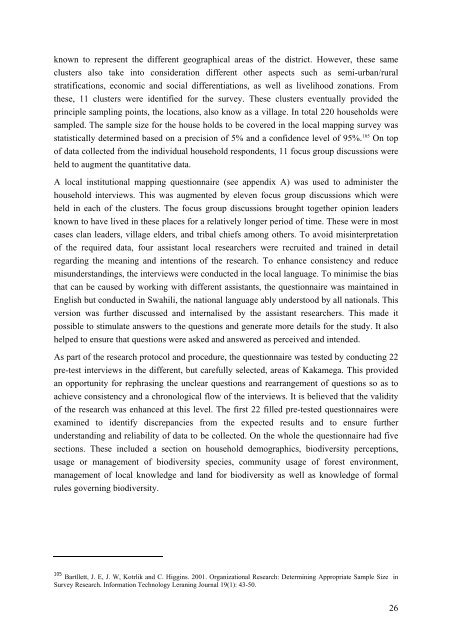THE UNIVERSITY OF LEIPZIG
THE UNIVERSITY OF LEIPZIG
THE UNIVERSITY OF LEIPZIG
You also want an ePaper? Increase the reach of your titles
YUMPU automatically turns print PDFs into web optimized ePapers that Google loves.
known to represent the different geographical areas of the district. However, these same<br />
clusters also take into consideration different other aspects such as semi-urban/rural<br />
stratifications, economic and social differentiations, as well as livelihood zonations. From<br />
these, 11 clusters were identified for the survey. These clusters eventually provided the<br />
principle sampling points, the locations, also know as a village. In total 220 households were<br />
sampled. The sample size for the house holds to be covered in the local mapping survey was<br />
statistically determined based on a precision of 5% and a confidence level of 95%. 105 On top<br />
of data collected from the individual household respondents, 11 focus group discussions were<br />
held to augment the quantitative data.<br />
A local institutional mapping questionnaire (see appendix A) was used to administer the<br />
household interviews. This was augmented by eleven focus group discussions which were<br />
held in each of the clusters. The focus group discussions brought together opinion leaders<br />
known to have lived in these places for a relatively longer period of time. These were in most<br />
cases clan leaders, village elders, and tribal chiefs among others. To avoid misinterpretation<br />
of the required data, four assistant local researchers were recruited and trained in detail<br />
regarding the meaning and intentions of the research. To enhance consistency and reduce<br />
misunderstandings, the interviews were conducted in the local language. To minimise the bias<br />
that can be caused by working with different assistants, the questionnaire was maintained in<br />
English but conducted in Swahili, the national language ably understood by all nationals. This<br />
version was further discussed and internalised by the assistant researchers. This made it<br />
possible to stimulate answers to the questions and generate more details for the study. It also<br />
helped to ensure that questions were asked and answered as perceived and intended.<br />
As part of the research protocol and procedure, the questionnaire was tested by conducting 22<br />
pre-test interviews in the different, but carefully selected, areas of Kakamega. This provided<br />
an opportunity for rephrasing the unclear questions and rearrangement of questions so as to<br />
achieve consistency and a chronological flow of the interviews. It is believed that the validity<br />
of the research was enhanced at this level. The first 22 filled pre-tested questionnaires were<br />
examined to identify discrepancies from the expected results and to ensure further<br />
understanding and reliability of data to be collected. On the whole the questionnaire had five<br />
sections. These included a section on household demographics, biodiversity perceptions,<br />
usage or management of biodiversity species, community usage of forest environment,<br />
management of local knowledge and land for biodiversity as well as knowledge of formal<br />
rules governing biodiversity.<br />
105 Bartllett, J. E, J. W, Kotrlik and C. Higgins. 2001. Organizational Research: Determining Appropriate Sample Size in<br />
Survey Research. Information Technology Leraning Journal 19(1): 43-50.<br />
26






